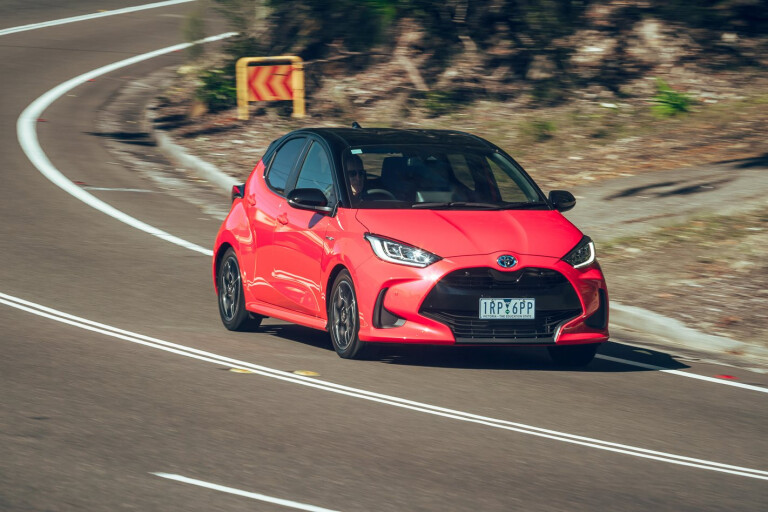
On the the face of it, it seemed Gen Y had ample ‘issues’ to keep them busy sooking and moaning. There’s the financially impenetrable housing market; the rising cost of smashed avo on toast; the discomfort of skinny jeans. But now Toyota has just added another nasty thorn to that list of woes: the bold introduction of the not-so-affordable small car.
Cars from this B-segment – like the Mazda 2, Suzuki Swift or previous-generation Yaris – have been go-to choices for 20-something drivers for years; a chance to get that new-car smell without the lingering stench of endless high monthly repayments. With their sub-$20,000 driveway price, a typical light car from a Japanese or Korean brand was pretty much all these buyers really needed, and included at least most of what they wanted.
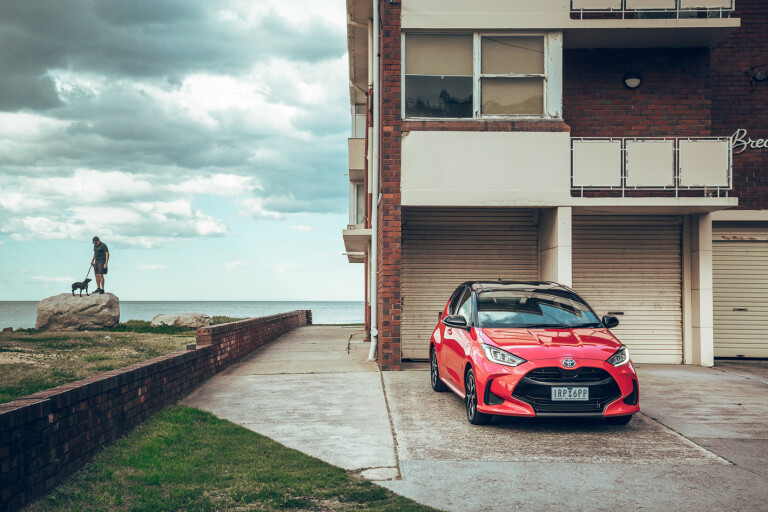
But in case you’ve missed it, the debut of the all-new fourth-generation Yaris brings pioneering powertrain tech and safety to the segment, but also saddles Toyota’s baby with the biggest percentage price hike in any automotive segment that anyone around here can ever recall. So while every new Yaris now includes centre airbags between the front seats (a class first), active cruise, AEB, reversing camera, as well as the option of a hybrid powertrain in middle and top spec levels is laudable and significant, the inescapable question remains: is anyone really ready for the $35,000 Japanese light car?
That’s the approximate drive-away price of the full-fruit Yaris ZR Hybrid auto you see on these pages. Basic breakdown: ZR spec with mandatory CVT retails for $30,100. Incorporating the hybrid system to the new atmo-petrol 1.5-litre three-cylinder engine adds $2000, while opting for the contrasting black roof is another $450. Add on-road costs and this is Toyota’s B-segment offering with a price tag very similar to that of an entry-level Audi A1 or Mini Cooper. Or, cross-shopped within the Toyota line-up, it’s over $2000 more expensive than a mid-spec Corolla SX Hybrid, and a mere $1100 cheaper than the company’s top-spec ZR Corolla Hybrid – both complete, obviously, with an appreciably roomier body and a stronger four-cylinder engine.
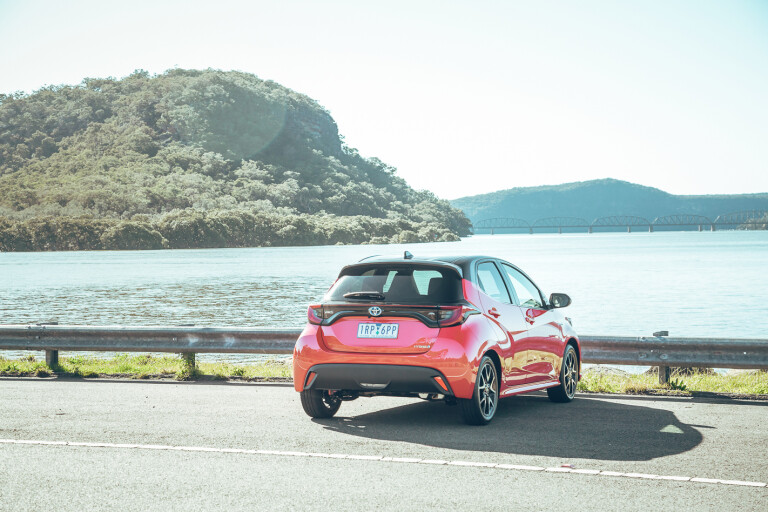
So why would you? That’s the mission for photographer Wielecki and myself as we leave behind the bustle of urban beachside Manly in Sydney’s north and head towards the NSW central coast. Let’s see if a decent chunk of motorway, twisty backroads and a solid stint of urban cut and thrust can build the value case for this premium-priced, pint-sized contender.
So, first impressions. Even before climbing inside, it’s evident that gen-four Yaris has bucked the inclination to go super-size. It remains very much a B-segment car, actually 5mm shorter and 5mm lower than the car it replaces, but the move to a simplified, strut/torsion-beam version of Toyota’s TNGA platform gifts it with an additional 40mm of wheelbase. I’m not overly enamoured with the exterior design – to my eye the front end looks like an angry kid inflating their mouth over your driver’s window as you stare down their oesophagus.

But happily the packaging is optimised, and the car’s centre of gravity is now around 15mm lower thanks in part to the powertrain’s positioning, as well as a lower hip-point for front occupants. Luggage space is class competitive at 270 litres, but legroom in the back is tight for adults sitting behind an average-sized driver, so it remains primarily a kids’ zone back there. But the first of a number of shocks comes once I’m squeezed in for research purposes and go looking for any ventilation, USB sockets, or a fold-down armrest. Really, Toyota? To misquote The Who: no, actually, the kids aren’t alright.

It’s much better up front, where the seats are generously sized, shoulder room between Wielecki and I is ample, and should I bin it in a moment of spectacular ineptitude, our heads won’t smash together like a couple of dropped watermelons thanks to those airbags in each of the inboard bolsters of the front seats. I’m happy with the driving position, too, thanks to decent seat travel and plenty of wheel adjustment. This ZR spec and the SX below it get a digital instrument cluster, which puts the drive mode and power meter in one circular pod, road speed in the one opposite, and multiple pages of configurable info in the centre. Oh, and a very good head-up display for ZR, too, although it’s invisible once I put on polarised sunglasses.
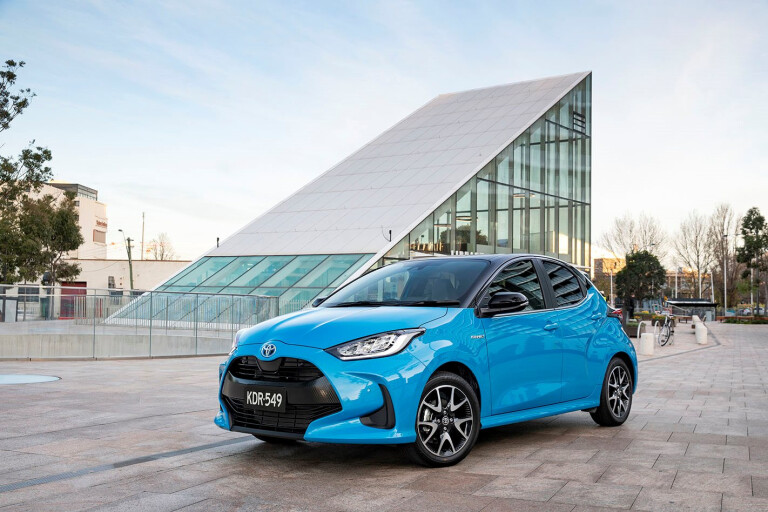
There’s a nook ahead of the gear selector to place your personal stuff, but no lidded console box, meaning valuables will sit there as tempting targets unless you lean over to the glovebox. Another miss. I’m also left to ponder the value of the ZR spec over SX. Yes, it adds blind-spot warning, rear cross-traffic alert, and rear AEB, as well as a rear window spoiler and inch-bigger alloys, but nearly $3100 seems steep.
Never mind. Hit the ignition, and thanks to ample charge in the tiny lithium-ion battery (a first for a Toyota hybrid, and at last a concession from the company that nickel-metal hydride is old tech) there’s no need for the three-pot to fire. Instead we move away with that lovely, seamless, near-silent EV step-off. But it’s only sustainable for a few car lengths and jogging pace before the engine is required, which joins the propulsion effort with a small tremor of vibration. There’s sufficient torque from both the electric motor (59kW/141Nm) and the petrol engine (running in more efficient Atkinson cycle here to deliver 67kW/156Nm) that you don’t need big throttle inputs to feel nimble and eager in urban traffic. That’s the good bit.

Boot sizes of Australia's favourite hatches
But as we join the motorway heading north and do give it wide-open throttle, it’s instantly clear that this compact, efficient new engine is no new benchmark for hushed smoothness, at least in this installation. It’s actually pretty vocal; not unpleasant, but louder than I was expecting, and utterly tuneless thanks to the CVT keeping it in a band of what sounds and feels around 4500-5000rpm (best guess, as there’s no tacho…). The ZR Hybrid is not quick when asked to deliver its all, either; a hand-time run later on will net 0-100km/h in 10.1sec; over half a second slower than mid/upper-spec VW Polos.

On a more positive note, the new Yaris does have a real sense of maturity and confidence in its surefootedness at motorway speeds, feeling massively removed from its flighty, fidgety predecessor. The steering, which is super light and direct at low speed, firms up nicely to be resolutely slack-free and attentive. Only coarse-chip road noise and average-level wind rustle pulls the little car down a few pegs in terms of long-distance cruising capability. The ride at speed is competently damped, meaning no queasy motion over undulations. Just a shame it’s a bit firm at the around-town speeds most owners will drive, turning terse and edgy when the tyres encounter anything with a lip.
Boot sizes of Australia's favourite hatches

Wielecki wants some dynamic photography and I’m keen to see how well the chassis’ strong first impressions translate on properly twisty stuff, so we exit for the historic river town of Brooklyn, grab a coffee, and join the iconic Old Pacific Highway. Happily, that sense of chassis maturity and engagement don’t wilt when it’s flung into bends. The 16-inch Bridgestone Ecopia rubber hangs on gamely then relinquishes progressively. The front end keenly resists understeer, instead quickly sharing the cornering load with the rear, so coherent balance is always on your side. The ESC on our car wouldn’t reliably disengage, but even with it activated, provided you’re smooth with both wheel and throttle inputs at the limit, it will allow tidy little slides without intruding. So there’s involvement and enjoyment to be had but, ultimately, the constant droning of the engine at highish revs under open throttle, thanks to the efficient but buzz-kill CVT, starts to dull the appeal of this mid-week, deserted backroad strafe.
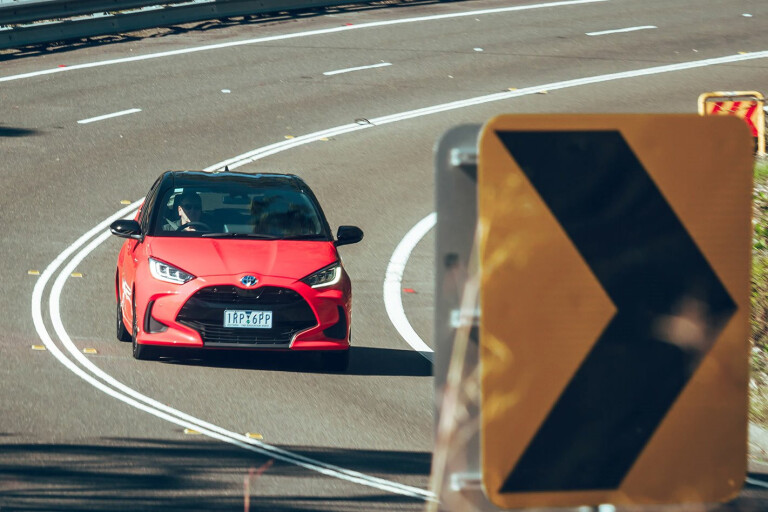
As we pull over in the little holiday town of Terrigal, it’s almost time to break open the take-away sushi, but first Wielecki wants an engine shot, so I pop the bonnet. As he disappears from view in front of the car, there’s suddenly a god-awful hacking and spitting noise, like an old dog coughing up a chicken carcass. Alarmed, I rush around to find Thomas pointing and foaming at his discovery – the lack of paint over the inner guards and under the bonnet. “That’s bloody primer!” our apoplectic Pole spits. His ire is understandable. Saving a few cents worth of paint here on a premium-price light car feels cynical in the extreme, and I have to hand-feed him salmon nigiri until the pain of it all slowly subsides. Which works, until he spots the rear drum brakes. They are pretty standard for his class, I explain. “Still doesn’t make ’em right on a $35K car,” he snarls.
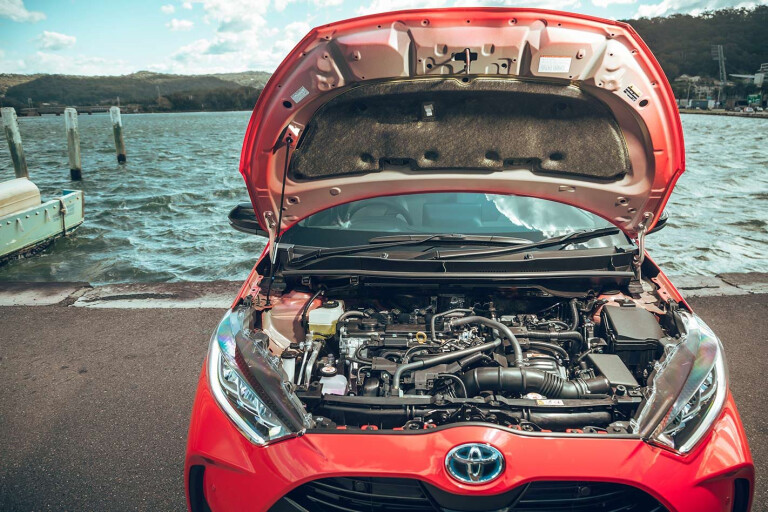
A quick refuel on the outskirts of Sydney shows consumption of 4.3L/100km (against the official combined figure of 3.3). That seems reasonable, given our hard driving and motorway running, where the hybrid system is not at its optimum. But it does raise the real-word consumption benefits of this car versus the regular petrol version. That car’s ADR consumption number is 4.9L/100km, or about 33 percent higher, but the $2000 premium for the hybrid buys a lot of fuel; enough to take you 15,000km, assuming the ADR figures were achievable. Given the minimal usefulness of the car in EV mode (about 800 metres at less than 40km/h), I’m still convinced a small turbo triple is a quieter, cheaper solution compared to an atmo+hybrid in this class, if not quite as frugal and green. I’m also left wondering what Yaris would be like as a BEV, with a larger battery replacing the current tiny lithium-ion unit, a bigger motor, and a deletion of the petrol triple. A terrifically quiet, refined, and peppy little car, I’d contend.
We conclude where we started, back on the northern beaches, and really in heartland territory for a car like this. At a busy crossing next to the ferry terminal at Manly, plenty of young couples, down-sizing seniors – and yes, even the occasional Gen Y – glance our way, eyes presumably caught by the bright metallic paint and edgy, tightly drawn exterior. Could they go further and see appeal in the benchmark safety suite, and the eco benefits of a hybrid powertrain?
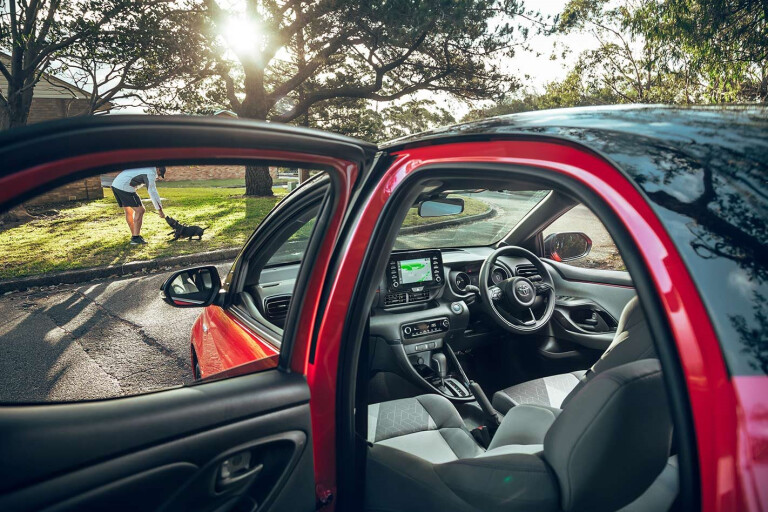
I wonder. Me, I really wanted to like the new Yaris, as I have a real soft spot for how well-suited cars of this size are to the majority of my driving needs. But reservations nag. As significant as its class innovations are, the new Yaris still needed to eclipse the B-segment benchmark Polo for grown-up refinement and overall polish to justify its new price position. Which it doesn’t quite manage.
Ultimately, though, a high outlay for any consumer product is tolerable if you’re resolutely convinced that the value equation is strong. This Yaris ushers in a new era for the small car where that question demands bigger consideration than ever.

COMMENTS